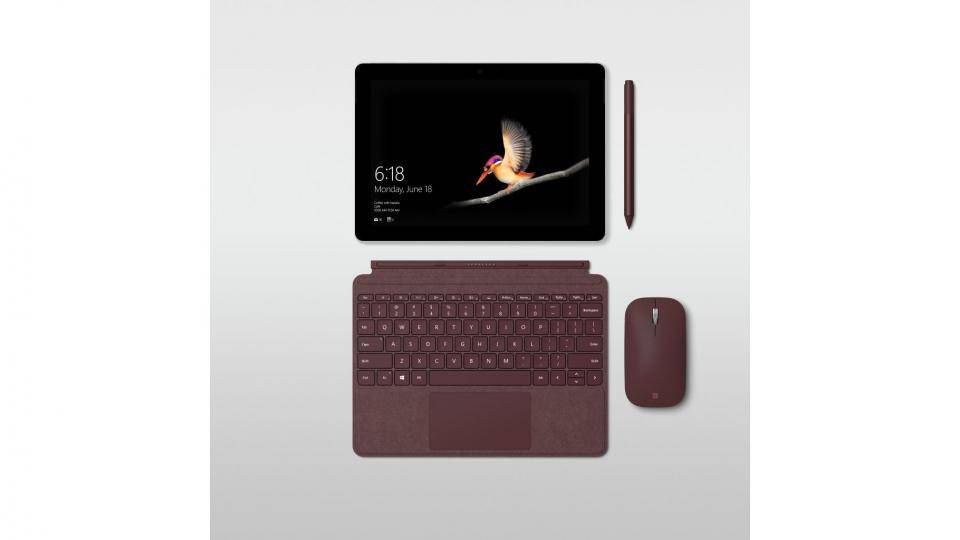Microsoft has officially confirmed the release of the Surface Go, its new budget 2-in-1 device aimed at students and those looking for an ultra-portable and versatile laptop.
Long-rumoured, the weeks leading up to the announcement saw Surface Go leaks and rumours abound. Perhaps thanks to those leaks, Microsoft officially announced the tablet in mid-July. Initially only available in the US, preorders are now live over here, with the tablet shipping from 23 August.
All well and good, but what exactly is the Surface Go? Luckily we have all the details about Microsoft’s new affordable tablet and have summed it all up for you just below. Read on to learn all about the new Microsoft Surface Go.
Microsoft Surface Go: Everything you need to know
Microsoft Surface Go UK release date: When’s it coming out?
Microsoft's Surface Go is available for preorder right now, with the tablet shipping (for free!) on 23 August. Initial rumours had claimed that the release date would be Friday 13 July but they ended up a few days wide of the mark.

Microsoft Surface Go price: How much will it cost?
The big draw for the new tablet is the price. The most affordable model comes in at £379 ($399 in the US), and there’s also a more expensive version at £509 ($549), which comes with more RAM and storage. That’s significantly cheaper than the rest of the £650+ Surface Pro range.
It isn’t the first time Microsoft has sold a cheaper version of the Surface. Its last budget effort was the Surface 3, a product you can still buy in some places, but Microsoft ceased production of at the end of 2016.
Accessories have also been announced, with the Surface Pen stylus coming in at £99.99, the Surface Mobile Mouse costs £29.99, and the Surface Precision Mouse will set you back £99.99. There’s also the Surface Type Cover – the keyboard – which isn't included as standard. A black version will cost you £99.99, while a Signature Type Cover in Alcantara, red, blue or silver comes in at £124.99.
READ NEXT: The best tablets you can buy today
Microsoft Surface Go specifications: What’s inside?
10in 1,800 x 1,200 display
Dual-core 1.6GHz Intel Pentium Gold 4415Y processor
4GB or 8GB RAM
64GB eMMC or 128GB SSD
Windows 10 S
£380 or £510
Late August
The Microsoft Surface Go has a 10in screen with a 3:2 aspect ratio display and a resolution of 1,800 x 1,200, which is the same as the Surface Pro. It’s smaller than the Surface Pro, though, at 244 x 8.3 x 175mm (WDH), and it’s lighter too, weighing 521g.
As for connectivity, the Surface Go has a USB Type-C 3.1 port, microSD card support and a 3.5mm microphone jack, and an LTE model will be arriving later in the year. An 8-megapixel rear camera is also included.
Two versions of the Go are initially available. The cheaper £379 model has 4GB of RAM and 64GB of eMMC storage, while the more expensive one has 8GB of RAM and 128GB of faster SSD storage.
Both models employ Intel’s seventh-generation Pentium Gold 4415Y CPU, a low-power chip that allows the Go to be fanless and offer a claimed nine hours of battery life. The tablet runs Microsoft’s restricted Windows 10 S operating system by default, which is no surprise since the company’s more expensive Surface Laptop does the same, although users will be able to switch to the full version if desired.
Microsoft Surface Go design: What does it look like?
The long and short of it is that it looks much like Microsoft’s other Surface devices. It’s the same shape as the Surface Pro, just smaller, and the keyboard and stylus both look similar as well. Otherwise, there’s no radical redesign of Microsoft’s existing offerings here.

Microsoft Surface Go features: What does it do?
As expected, it does a lot of the same stuff as its bigger brother, the Surface Pro, albeit in a smaller package. It’s a smaller, cheaper Windows 10 Surface device that can run all the same full-blown applications as its larger sibling, assuming you take advantage of the free software upgrade of course.
You’ll be able to run Adobe Photoshop or Illustrator, browse the web or watch Netflix, just as you can with the bigger devices. The only worry we have is over the raw power – or lack of it – on offer from the Pentium processor. Other devices we’ve tested with Pentium CPUs have not been the most responsive or nippy.
We’ll report back in more detail when we get our hands on a review sample, but don’t expect to be able to run hefty multitasking jobs or edit 1080p video on this thing.
Microsoft Surface Go: Early verdict
The Surface Go certainly seems to fill a gap in the range for Microsoft and we were fans of the Surface 3, not least because it offered many of the advantages of Microsoft’s brilliant 2-in-1 design from the full-blown Surface Pro.
The only surprise is that it’s taken the company two years to refresh the design and the only worry is that the specifications look very basic indeed, especially that Pentium CPU.

